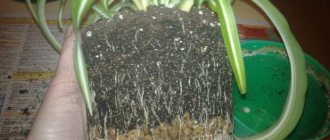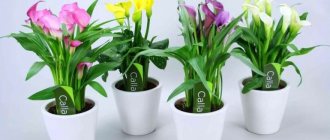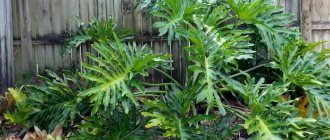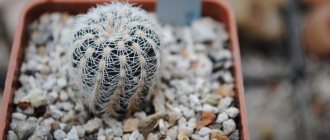Photo Hoya (Hoya) is an exotic plant native to Southeast Asia , growing in India, the Polynesian islands, and the Australian continent. The common name is wax ivy.
The tropical flower Hoya belongs to the subfamily Lastovnevye (Lastovniaceae). Depending on the variety, it occurs in nature in the form of herbaceous vines, epiphytes and shrubs.
Distinctive characteristics of the evergreen hoya plant are dark green glossy leaves (hairy, bare) and beautiful voluminous umbrella-shaped inflorescences (pink, white, yellow, burgundy).
The climbing vine can reach a length of 2-10 m, the height of the shrubs does not exceed 60 cm. The perennial is characterized by an average growth rate of 20-30 cm per year.
| Average growth rate, 20-30 cm per year. |
| Blooms from early summer to early autumn. |
| The plant is easy to grow |
| Perennial |
Growing
There are some features when breeding this flower:
- Hoya loves light, so it is advisable to keep it on the south side. But at the same time, it should not be left in direct sunlight for a long time. It is necessary to create shade, otherwise burns will appear on the leaves.
- If the hoya gets enough light, you will soon see flowers on it. If buds appear, then it does not need to be moved to another place.
- It is better to protect this plant from drafts and sudden changes in temperature. Also, you can’t keep it in the cold. If the temperature is less than 10 degrees, the flower will die.
- It will be good for hoya if the soil where it is located is fluffy and light.
- In order for the plant to develop normally, it must be constantly fed with fertilizers.
- The soil should not be completely dry; as soon as it dries, it should be watered immediately.
- This plant loves to be sprayed.
Some types of hoya are very capricious in relation to the soil, and there are also those who will not be able to develop normally at temperatures less than 20 degrees.
Breeding Hoya
Hoya propagation is a simple process, but it is based on certain rules. Reproduction is carried out in the spring in three ways:
- layering;
- vaccination;
- cuttings.
In order to propagate hoya by cuttings, you need to take cuttings 10 cm long, but only from the tops. For further planting, a peat-sand mixture is prepared. You can also use phytohormones, which improve the process of root formation and growth. After the cuttings are planted in the peat-sand mixture, they are covered with a small piece of polyethylene; the temperature should be no lower than 18 ° C and no higher than 24 ° C. After the cuttings have taken root, they are transplanted into separate cups filled with a mixture of peat and sand.
We recommend watching the video on how to grow hoya from cuttings.
Plant care
Location: Hoya should be grown in bright rooms. The best place for wax ivy is western and eastern windows. A little direct sun is beneficial, but during the hottest days in summer the plant needs to be shaded.
Temperature: during the period of active growth, the optimal air temperature is about 22-25°C. It is necessary to ventilate the room where the hoya is located, but it cannot be taken out into the open air. In winter, the air temperature should not exceed 12-15°C (for Hoya beautiful, the winter minimum is 18°C). It can overwinter at higher temperatures, but flowering next year will not be as abundant.
Watering: in spring and summer, it is recommended to water Hoya abundantly, but trying to avoid waterlogging, and during flowering, make sure that water does not get on the flowers; In winter, the water regime changes depending on the temperature, but the earthen clod should not be allowed to dry out. It is recommended to use well-settled water for irrigation.
Abundant flowering can be stimulated by immersing the entire plant for 30 minutes in warm water at a temperature of 35°C, and a lump of earth in the same water for 2 hours.
Air humidity: in a cool room it is undemanding, but at temperatures above 20°C it is necessary to frequently spray the leaves. For spraying, use only soft water, otherwise spots will form on the leaves. Once a week, the leaves should be wiped with a damp cloth to remove dust.
Feeding: starting in spring and throughout the growing season, Hoya is fed twice a month with floral mineral fertilizers, after which the soil must be loosened without damaging the roots. Grows well in hydroponics.
Transplantation: young plants are replanted annually in the spring, older specimens - after 2-3 years. The best substrate is considered to be a mixture of leaf and turf soil, humus, peat and sand (2:1:1:1:1). Good drainage is installed at the bottom of the pot so that the earthen ball does not become waterlogged. It is also necessary to take care of support for quickly growing long shoots.
In order for the plant to branch better, long stems are pinched. If the shoots become too long, some can be cut off. It is better to cut off long growth shoots, leaving short branches on which flowering occurs.
Pests: with insufficient care, scale insects and red spider mites can settle on the hoya. The plant is often affected by powdery mildew (mildew).
Red spider mites appear on a plant if it is kept at excessively high temperatures and dry air. Light brown or small white spots form on the leaves. The leaves turn yellow, dry out and fall off. The plant is delayed in growth and development. It is necessary to increase the air humidity around the plant, and treat the plant itself with Actellik (15-20 drops per 1 liter of water).
The appearance of scale insects is also extremely unpleasant. The plant takes on a sloppy appearance: the leaves dry out and fall off. A sooty fungus settles on the secretions of scale insects. Scale insects are cleaned with a cloth moistened with soapy water or alcohol. In case of severe infection, the plant should be taken out of the apartment and treated with karbofos.
To combat sucking insects, you can also use infusions of garlic and onions. Take 1 teaspoon of finely chopped onion or 1/2 teaspoon of garlic and leave it in a closed glass of water for 24 hours, then wash the plant with this infusion.
Powdery mildew affects the leaves of the plant, causing a white coating to appear on them. On a neglected plant, powdery mildew covers the buds and stems. It is necessary to increase ventilation in the room and increase air humidity.
Precautions: The flowers of the plant smell. The smell can cause somatic reactions (eg headache). Leaves can cause contact dermatitis.
Possible difficulties:
Due to too low temperatures or excessively bright sun, the leaves turn pale, begin to dry out and curl.
Leaves fall due to too dry and hot air.
From excess or lack of moisture, as well as from too dry and hot air, flower buds fall off.
Stagnation of water and cold water used for irrigation may cause leaves or shoots to fall off.
Excess moisture in the soil can cause the roots and base of the stem to rot.
With a lack of light and a change in location, flowers may fall off.
If there is a lack of nitrogen in the soil, plant growth slows down, the leaves become pale green (feeding with urea at a concentration of 1 g/l is required).
Too low temperatures and over- or under-watering can cause leaves to yellow, wilt, and fall off.
Hoya in home floriculture
In order to grow this flower at home, you need to choose its size. Many types of hoya grow large. But you can also choose those that fit easily on the windowsill.
The plant can simply be hung or placed in a certain place, and the branches will curl around the pot. While the plant is young, its stems are flexible and elastic, but then they can break if you try to bend them.
This flower is easy to care for and can be grown at home. In any case, this plant will always reward you with its decorative appearance, which will remain so as long as it is properly cared for.
Types of Hoya
The most common houseplants are Hoya Kerra and Fleshy.
Kerrii has shoots that can reach 2 meters in length. But it is not the flexible creeping shoots of the steeplechase that attract attention, but the large leathery leaves in the shape of an inverted heart. The length and width of the leaves of this hoya reach 15 cm, and their color - rich, bright green - creates a feeling of freshness. The umbrella-shaped inflorescences are very elegant. They contain numerous white flowers with a beautiful dark center and a base creamy color. The species grows slowly, remains stable in indoor culture and is well managed. In addition to the base plant, the variegata form with cream leaves is also very popular.
The more modest-sized fleshy hoya (Hoya carnosa) also deserves the attention of gardeners. It is this plant that is originally called wax ivy . The shoots of the vine grow only up to 1 m, but it will outshine its fellows in the canopy culture. An elegant, if not graceful, plant needs a garter, flaunting fleshy, rather dark glossy leaves of a pointed shape, smaller than those of other species. If you look closely, you can see small whitish and yellowish spots on the leaves of wax ivy. This hoya forms dense bushes and its leaves are evergreen. The inflorescences sit on short stalks, in small umbrellas. The individual flowers of wax ivy are very beautiful, star-shaped with a red crown in the center, giving the entire inflorescence a variegated appearance. In addition to the basic type, there is a more small-leaved Hoya of the compact form.
It is also worth paying attention to other types of hoya:
- The ampelous small-leaved beauty Hoya bella is a dwarf species that, although less common, is also very decorative. It is not so lush, but more densely leafy, with beautiful oval-shaped leaves up to 3 cm long with a pointed tip and numerous small drooping star-shaped flowers with a crimson center.
- Hoya imperialis (Hoya imperialis) is a climbing species with pubescent shoots, large oval leaves up to 20 cm long with an edge rounded at the base and pointed at the apex. The flowers are collected in hanging umbels, pink-red, with a pubescent crown, seeming like a shining vision.
- Hoya multiflora (Hoya multiflora) is a compact species with narrow, up to 14 cm leaves, unusually thin, prominent veins and yellow-white flowers, in which the outer star seems to be bent back. This hoya is famous for its lemon scent, flowers reminiscent of shooting stars, collected in inflorescences of up to 40 flowers each.
- Hoyas are vines that are not so difficult to grow. But they require really careful care, constant monitoring and careful correction of conditions at the slightest sign of “dissatisfaction.” These beauties need sensitive, caring owners who can satisfy all their needs and provide the necessary care.
Hoya in different seasons
This plant blooms even in winter. If you want to create such beauty for yourself, then you need to prepare the flower for this in September. To do this, place the container with the plant on the east side.
At the beginning of winter, the flower is watered very little, and as a result, flowers appear on the plant. The most ideal temperature for this period of time is 15 degrees Celsius.
There are also types of hoya that do not like coolness; these include multiflora. If the temperature is below 20 degrees, then it loses leaves and flowers.
As a rule, winter is an opportunity for Hoya to rest, and at this time it is better to water and fertilize it less. It blooms in the warmest times of the year, just when it needs constant care. And all this time the flower needs light.
Description of the plant
Hoya is an evergreen vine that arrived in Europe from the tropics. About two hundred species of this plant have been found in nature, which can be found in Asia, Australia, Madagascar, the Polynesian and Canary Islands.
Hoya received its scientific name at the end of the 18th century from the English botanist Brown. He named the vine in honor of the famous European gardener and specialist in growing tropical plants in greenhouses - Thomas Hoy.
And although Hoya is in no way related to the ivy family, in everyday life it is nicknamed “wax ivy.” The vine received this nickname because of the glossy sheen of its outer parts: the surface of the leaves and flowers looks as if it was covered with a thin, protective layer of wax.
Wild hoya spreads along the ground and can grow up to 10 meters in length, entwining other plants and even completely destroying them.
Cultivated hoya does not exceed five meters and can take any shape. Therefore, they are grown as hanging plants, as shrubs, and as vines for entwining walls and arches.
Hoya stems change over time:
- initially they are purple bare shoots;
- as they mature, their color changes to green and they become covered with leaves and aerial roots;
- adult shoots become completely lignified.
The color, shape and size of the leaves depend on the species. The foliage is united only by a waxy glossy sheen, which disappears in adult leaves and they become dull.
All types of hoya bloom. Flowers are collected in lush inflorescences of numerous flowers. The size, color and even smell of flowers also vary depending on the species, but like the leaves, each flower is as if covered with wax.
Hoya flowers are very fragrant, which makes them attractive to insects. Therefore, hoya has cultural significance, as it is a honey plant.
However, as a houseplant, it is not suitable for everyone. The vine sap is poisonous and can lead to allergic skin rashes. The intoxicating aroma of hoya flowers also causes allergies and provokes headaches. Flowers emit a particularly concentrated scent at night. Therefore, it is not recommended to keep indoor Hoya in bedrooms or children's rooms.
Watering a flower
When it is very hot, this flower needs to be watered abundantly, because it is precisely at this time that it grows. But in autumn and winter this is done less. Watering should be done with settled and soft water when the soil on top dries out.
To induce flowering, the plant can be placed in a bucket filled with warm water at 30-35°C. You need to fill it to the top of the pot and leave it there for 1 hour. After this, the container with the flower is removed and placed in the place where it already stood.
Propagation by cuttings
- Cuttings with two or three nodes are cut from the lashes, and the leaves from the lower node are removed. Leave for 2-3 hours for the sections to dry.
- Then the sections are dipped in root.
- The treated cuttings are placed in a dark glass.
- When the roots grow 2-4 cm, they are planted in moist soil.
If you planted the cutting directly into the soil, cover the top with plastic.
Advantages of the method:
- cuttings are always in abundance;
- nodules give roots within 2 weeks;
- cuttings take root quickly.
Minuses:
- Do not touch with your hands, the roots are very fragile.
- It is necessary to spray daily and maintain a constant temperature of 22 degrees. Even briefly airing the room can kill the cutting.
- Cuttings can stand for up to 6 months without growing.
Pests often settle on the lashes of Hoya Retuz, which may not be noticed in time. Before planting, treat the cuttings with soap and tobacco water.
Choosing a pot and soil
A small pot is enough for this plant to thrive. Its usual environment is large trees and rocks. Therefore, when planting this flower at home, you need to plant it in small containers where air can flow well. In the photo you can see how hoya looks great in a small pot.
It doesn’t matter what the container is made of, any material will do. The soil where the plant will move should preferably be loose, with the addition of humus from the leaves. As a rule, many types of hoya grow quietly in any soil. But some varieties require limestone in the substrate.
Botanical characteristics
Botanical name: Hoya sp.curtisii. The plant is a small-leaved epiphyte with well-developed clinging aerial roots formed from leaf nodes.
Description:
- trunk diameter up to 0.2-0.4 cm;
- the shape of the foliage is rounded, the ends are pointed in the form of a triangle, the structure is fleshy, thick, the inner and outer surfaces are rough, the color is green with a gray tint and a silvery tint, length about 1.5 cm, width up to 2 cm;
- peduncles short, up to 5 mm;
- inflorescences are umbrella-shaped, convex, up to 2 cm in diameter, matte yellow in color with a brown or cream tint, red in the middle, formed by spade-shaped petals with pointed ends, fleecy surface, bent backwards when fully bloomed.
The flowering period occurs in late autumn, but the beginning of budding in other seasons is not excluded. Duration - about 3 weeks.
Planting and transplanting
Transplantation should be done no more than once every two years.
The fact that this flower has adventitious roots makes this process easy. To do this, a well-developed flower stem is placed in a container with soil and secured with wire. After the shoot has given roots, it is separated from the main plant.
When a flower is transplanted to a new place, the container should be slightly larger than the one from which the flower is transplanted. Hoya blooms only when its roots completely fill the entire space in the pot.
There must be a good drainage layer so that the water drains well after watering. The soil must be sufficiently loose and fertile; for this purpose, special mixtures can be used.
What is it sick with?
Spots on leaves
- Yellow spots are a sign of lack of light.
- If you see a black or brown spot, rub the leaf with your fingers. If the stain is erased, then it is a fungus. Treat with a fungicidal agent. If it remains on the leaf, it is a viral infection. Isolate Hoya Retuza from other plants and treat with an antiviral drug.
Insect pests
Parasites settle on roots, stems and leaves.
- Root nematodes are microscopic worms. The roots rot from them. Remove the plant from the ground, wash the root with hot water, and treat with an insecticide. Then replant in new sterile soil.
- Scale insects and whiteflies suck sap from leaves and stems. They look like small reddish cocoons. Treat Hoya with an insecticide every 2 weeks until it recovers.
The health of this species is good; the plant’s immunity deteriorates only with insufficient lighting and excessive watering.
Flower growers consider Hoya Retuza one of the most unpretentious representatives of hoya. The right place, a little care - and she will delight you with her exotic beauty for years.
Temperature
It must be provided the same as for most other types of indoor flowers. Summer care is different from winter care. In the hot season, the optimal temperature is 23–25 ° C, and in the cold season it can be reduced to 14–16 degrees.
Hoya flowers do not like drafts. In winter, during severe frosts, the plant is transferred from the windowsill to a table or shelf, most importantly, away from heating elements.
The flower does not require too much moisture, but so that the leaves do not lose their freshness, it must be constantly sprayed. Water should only fall on the greens and avoid flowers and buds.
Conditions for good flowering
The plant will please you if:
- grow it in cramped pots;
- do not remove faded shoots, as new inflorescences form in place of the old flowering;
- remove only bad or dead leaves or only sprouts where there is no flowering;
- As soon as the buds appear, do not touch or move the hoya.
Look how beautiful the Chloe flower is in the photo below.











